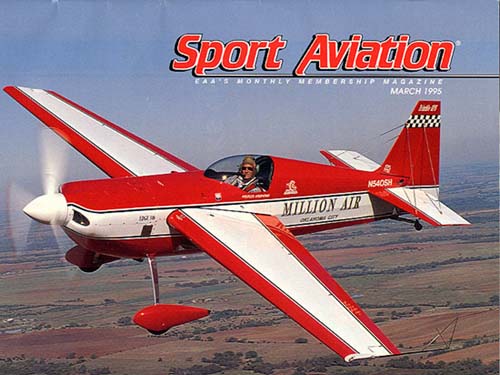
PIREP: Zivko Edge 540

PAGE THREE The skin itself is glass with a foam core stabilizing the skin. The ribs are Nomex filled, carbon fiber layups and the spars are mostly carbon fiber. The layups are done in a clean room that doubles as a paint booth and curing is done in Zivko's own 26 foot long oven. The fuselage is relatively traditional, having evolved from the Lazer with careful attention paid to those areas where several decades of competition have revealed weak points. This is another area in which Zivko took advantage of those experts who know what works and what doesn't. They carefully documented the histories of performers and competitors who are flying similar types of tubing structures and noted where they were having problems. Then they sat down with their own computers and proceeded to design an entirely new fuselage which hopefully eliminated all those problems. Although the fuselage looks to be a Lazer derivative, it is actually a completely new, computer designed structure. Next in their development program will be replacing the wire-braced empennage with a completely composite unit. Weight, weight and weight are the first three factors constantly nagging at the mind of any aerobatic designer. Lowering the weight is the same as gaining free horsepower and in competition, every ounce counts. In the case of the Edge 540, the quest for ever-lower weight brought composites into play in many areas other than primary structures.
Practically every external fairing which would normally be made of aluminum is carbon fiber. This includes the turtle deck, canopy frame and even the instrument panel. The cowling, complete with nose bowl and all fasteners barely weights 12 pounds which shows the concept does work. The super slick and tight fitting canopy frame doesn't have a bolt or screw showing because the canopy, as well as all Plexiglas panels, is all bonded in place rather than being bolted. This makes for light, rigid installations that can be replaced by simply sanding the back of the mounting flange away and bonding in a new piece. The engine in the EDGE 540 we flew was powered by a mildly tuned Monte Barrett, parallel valve IO-540 pushing about 310 hp (dyno verified) into the air via an MT three-blade. In the Edge 540 kits or finished aircraft, the propellor of choice would be a three-blade, composite Hartzell. The net result of all their attention to detail is an unlimited aerobatic airplane with a 20 G wing that, in the case of the example we flew, barely weights 1170 pounds. With a normal aerobatic weight of 1527 pounds, that puts the power loading at under 5 lbs/hp. No wonder it is such a rocketship! The price of a complete kit, minus the usual engine and all other kit stuff that isn't usually included, is $57,052, which includes every single option including having the wing pre-mounted to the fuselage and all tubing finished, painted and pre-oiled. This also includes the wing tank option that gives an additional 33 gallons over the 19 gallons in the fuselage tank. Zivko stresses that even though they've done much of the work there is still a fair amount of work to be done by a builder. They view their kit as being half way between a plans-built airplane and a true, ready-to-assemble kit. Incidentally, of the total price, $18,995 is for the basic wing which can also be fitted to your old Lazer fuselage, should you have an extra one laying around.
Mark Pfiefler, an airshow performer and professional pilot from the Oklahoma City area not only loaned us his airplane for the pilot report, but did the flying during the photo session. He showed a tremendous amount of patience and self control in hiding his apprehension at having someone else fly his "baby", although those watching during the flight said he was pacing the ramp like an expectant father. Can't say as we blame him. A walk-around on the airplane shows the standard stuff expected of an
unlimited airplane except you seldom see it done this well. The gaps at
the back of the canopy combing, for instance, couldn't have been .025" and
were absolutely even from one end to the other. Ditto the cowling or anywhere
else anything came together. The turtle deck combing flowed down around
the vertical fin and was finished with a neatly detailed little window
that put the elevator horn in full view for pre-flighting. A nice touch! |